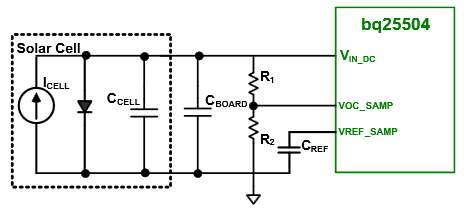Application Report SLUA632
March 2012
Umar Lyles, Yogesh Ramadass
Battery Charge Management System and Design
The bq25504 is an ultra-low-power charger IC intended for interfacing DC sources like solar cells, thermal harvesters and high-impedance batteries. The bq25504's industry-leading low-quiescent current and high charger efficiency make it an ideal choice for charging batteries and super-capacitors from a variety of energy-harvesting sources. This application note details how to optimize the bq25504 maximum power point tracking (MPPT) network to accurately regulate different types of solar cells to their maximum power point (MPP).
The Texas Instrument's bq25504 uses the open-circuit voltage (OCV) technique to regulate the solar cell to its maximum power point (MPP). This technique relies on the fact that for most solar cells, the MPP is achieved at some fraction of the OCV, typically 80%. A resistor divider (R1 and R2) is used to obtain the appropriate percentage of the solar panel's OCV. During normal operation, the bq25504 periodically turns off the charger so the solar panel can return to its OCV. During this time, the fractional voltage generated from the divider network is sampled and held by the capacitor, CREF. The voltage on CREF is used as a reference voltage to regulate the panel's operating voltage.
The bq25504 has a preset 256-ms OCV sampling period that is refreshed every 16 s. For most commercially available solar cells, the 256-ms time interval is adequate for ICELL to charge the solar cell's internal capacitance (CCELL) and the board capacitance (CBOARD) to settle the voltage at VIN_DC to the OCV of the solar cell, even under low light conditions. This is true for most solar cells because the capacitance at VIN_DC is approximated as CBOARD, because CCELL is usually small and ICELL is usually greater then 20 µA. However, some solar cells have a very large CCELL and/or a very small ICELL such that the voltage at VIN_DC no longer settles to OCV in the 256-ms sampling window. Under these conditions, the sampled voltage will actually show up as something less than the target fraction of OCV that R1 and R2 are normally set to achieve. To better understand how this phenomenon affects the selection of the MPPT resistor divider network the solar cell is approximated as a simple RC settling network.
Download Application Report SLUA632 (127 Kb)

bq25504 MPPT System Diagram
